哈萨克斯坦油气行业概述专题培训课件
- 格式:ppt
- 大小:2.43 MB
- 文档页数:45
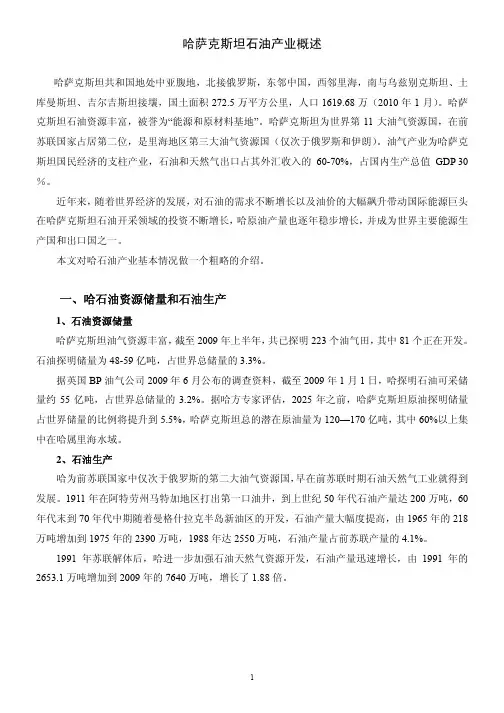
哈萨克斯坦石油产业概述哈萨克斯坦共和国地处中亚腹地,北接俄罗斯,东邻中国,西邻里海,南与乌兹别克斯坦、土库曼斯坦、吉尔吉斯坦接壤,国土面积272.5万平方公里,人口1619.68万(2010年1月)。
哈萨克斯坦石油资源丰富,被誉为“能源和原材料基地”。
哈萨克斯坦为世界第11大油气资源国,在前苏联国家占居第二位,是里海地区第三大油气资源国(仅次于俄罗斯和伊朗)。
油气产业为哈萨克斯坦国民经济的支柱产业,石油和天然气出口占其外汇收入的60-70%,占国内生产总值GDP 30%。
近年来,随着世界经济的发展,对石油的需求不断增长以及油价的大幅飙升带动国际能源巨头在哈萨克斯坦石油开采领域的投资不断增长,哈原油产量也逐年稳步增长,并成为世界主要能源生产国和出口国之一。
本文对哈石油产业基本情况做一个粗略的介绍。
一、哈石油资源储量和石油生产1、石油资源储量哈萨克斯坦油气资源丰富,截至2009年上半年,共已探明223个油气田,其中81个正在开发。
石油探明储量为48-59亿吨,占世界总储量的3.3%。
据英国BP油气公司2009年6月公布的调查资料,截至2009年1月1日,哈探明石油可采储量约55亿吨,占世界总储量的3.2%。
据哈方专家评估,2025年之前,哈萨克斯坦原油探明储量占世界储量的比例将提升到5.5%,哈萨克斯坦总的潜在原油量为120—170亿吨,其中60%以上集中在哈属里海水域。
2、石油生产哈为前苏联国家中仅次于俄罗斯的第二大油气资源国,早在前苏联时期石油天然气工业就得到发展。
1911年在阿特劳州马特加地区打出第一口油井,到上世纪50年代石油产量达200万吨,60年代末到70年代中期随着曼格什拉克半岛新油区的开发,石油产量大幅度提高,由1965年的218万吨增加到1975年的2390万吨,1988年达2550万吨,石油产量占前苏联产量的4.1%。
1991年苏联解体后,哈进一步加强石油天然气资源开发,石油产量迅速增长,由1991年的2653.1万吨增加到2009年的7640万吨,增长了1.88倍。
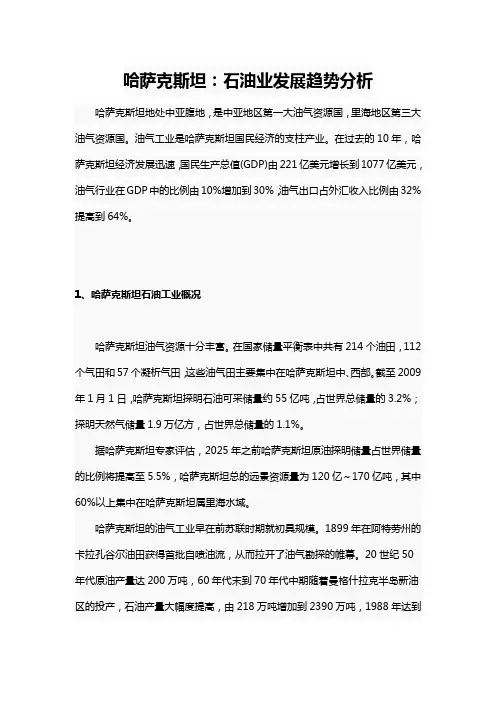
哈萨克斯坦:石油业发展趋势分析哈萨克斯坦地处中亚腹地,是中亚地区第一大油气资源国,里海地区第三大油气资源国。
油气工业是哈萨克斯坦国民经济的支柱产业。
在过去的10年,哈萨克斯坦经济发展迅速,国民生产总值(GDP)由221亿美元增长到1077亿美元,油气行业在GDP中的比例由10%增加到30%,油气出口占外汇收入比例由32%提高到64%。
1、哈萨克斯坦石油工业概况哈萨克斯坦油气资源十分丰富。
在国家储量平衡表中共有214个油田,112个气田和57个凝析气田,这些油气田主要集中在哈萨克斯坦中、西部。
截至2009年1月1日,哈萨克斯坦探明石油可采储量约55亿吨,占世界总储量的3.2%;探明天然气储量1.9万亿方,占世界总储量的1.1%。
据哈萨克斯坦专家评估,2025年之前哈萨克斯坦原油探明储量占世界储量的比例将提高至5.5%,哈萨克斯坦总的远景资源量为120亿~170亿吨,其中60%以上集中在哈萨克斯坦属里海水域。
哈萨克斯坦的油气工业早在前苏联时期就初具规模。
1899年在阿特劳州的卡拉孔谷尔油田获得首批自喷油流,从而拉开了油气勘探的帷幕。
20世纪50年代原油产量达200万吨,60年代末到70年代中期随着曼格什拉克半岛新油区的投产,石油产量大幅度提高,由218万吨增加到2390万吨,1988年达到2550万吨。
1991年前苏联解体后,随着哈萨克斯坦对油气资源开发力度的进一步加强,油气产量得到了迅速增长,原油产量由3013万吨增加到7640万吨。
与油气生产规模相比,哈萨克斯坦国内的原油消费量不大,约有80%以上的原油用于出口,2009年出口原油及凝析油共6726万吨。
过去,哈萨克斯坦油气主要出口到俄罗斯。
为降低原油出口对俄罗斯的依赖,哈萨克斯坦不断加强石油出口管道的建设,并取得了一定成效。
哈萨克斯坦现有以下主要出口管线:北线经阿特劳一萨马拉管道至新罗西斯克港出口到欧洲市场,占总出口量的26.O%;西线经里海国际石油财团管道系统(CPC)出口,占总出口量的51.4%;南线经由与伊朗达成的协议,占总出口量的6.7%;东线经中哈原油管道出口到中国,占总出口量的11.5%。

哈萨克斯坦石油产业概述哈萨克斯坦共和国地处中亚腹地,北接俄罗斯,东邻中国,西邻里海,南与乌兹别克斯坦、土库曼斯坦、吉尔吉斯坦接壤,国土面积272.5万平方公里,人口1619.68万(2010年1月)。
哈萨克斯坦石油资源丰富,被誉为“能源和原材料基地”。
哈萨克斯坦为世界第11大油气资源国,在前苏联国家占居第二位,是里海地区第三大油气资源国(仅次于俄罗斯和伊朗)。
油气产业为哈萨克斯坦国民经济的支柱产业,石油和天然气出口占其外汇收入的60-70%,占国内生产总值GDP 30%。
近年来,随着世界经济的发展,对石油的需求不断增长以及油价的大幅飙升带动国际能源巨头在哈萨克斯坦石油开采领域的投资不断增长,哈原油产量也逐年稳步增长,并成为世界主要能源生产国和出口国之一。
本文对哈石油产业基本情况做一个粗略的介绍。
一、哈石油资源储量和石油生产1、石油资源储量哈萨克斯坦油气资源丰富,截至2009年上半年,共已探明223个油气田,其中81个正在开发。
石油探明储量为48-59亿吨,占世界总储量的3.3%。
据英国BP油气公司2009年6月公布的调查资料,截至2009年1月1日,哈探明石油可采储量约55亿吨,占世界总储量的3.2%。
据哈方专家评估,2025年之前,哈萨克斯坦原油探明储量占世界储量的比例将提升到5.5%,哈萨克斯坦总的潜在原油量为120—170亿吨,其中60%以上集中在哈属里海水域。
2、石油生产哈为前苏联国家中仅次于俄罗斯的第二大油气资源国,早在前苏联时期石油天然气工业就得到发展。
1911年在阿特劳州马特加地区打出第一口油井,到上世纪50年代石油产量达200万吨,60年代末到70年代中期随着曼格什拉克半岛新油区的开发,石油产量大幅度提高,由1965年的218万吨增加到1975年的2390万吨,1988年达2550万吨,石油产量占前苏联产量的4.1%。
1991年苏联解体后,哈进一步加强石油天然气资源开发,石油产量迅速增长,由1991年的2653.1万吨增加到2009年的7640万吨,增长了1.88倍。


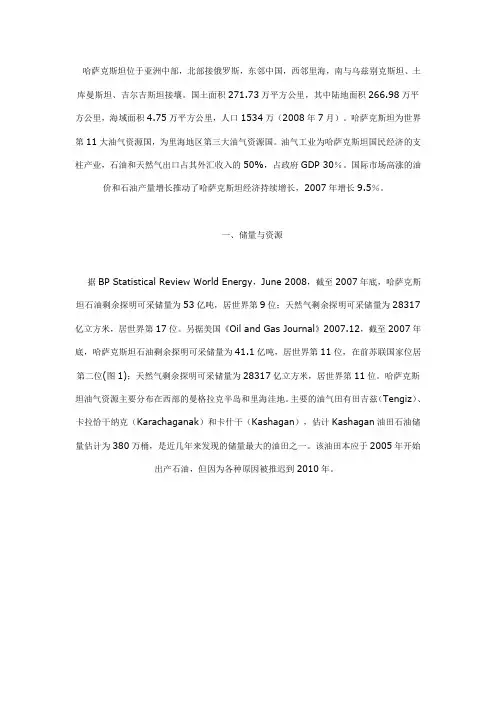
哈萨克斯坦位于亚洲中部,北部接俄罗斯,东邻中国,西邻里海,南与乌兹别克斯坦、土库曼斯坦、吉尔吉斯坦接壤。
国土面积271.73万平方公里,其中陆地面积266.98万平方公里,海域面积4.75万平方公里,人口1534万(2008年7月)。
哈萨克斯坦为世界第11大油气资源国,为里海地区第三大油气资源国。
油气工业为哈萨克斯坦国民经济的支柱产业,石油和天然气出口占其外汇收入的50%,占政府GDP 30%。
国际市场高涨的油价和石油产量增长推动了哈萨克斯坦经济持续增长,2007年增长9.5%。
一、储量与资源据BP Statistical Review World Energy,June 2008,截至2007年底,哈萨克斯坦石油剩余探明可采储量为53亿吨,居世界第9位;天然气剩余探明可采储量为28317亿立方米,居世界第17位。
另据美国《Oil and Gas Journal》2007.12,截至2007年底,哈萨克斯坦石油剩余探明可采储量为41.1亿吨,居世界第11位,在前苏联国家位居第二位(图1);天然气剩余探明可采储量为28317亿立方米,居世界第11位。
哈萨克斯坦油气资源主要分布在西部的曼格拉克半岛和里海洼地。
主要的油气田有田吉兹(Tengiz)、卡拉恰干纳克(Karachaganak)和卡什干(Kashagan),估计Kashagan油田石油储量估计为380万桶,是近几年来发现的储量最大的油田之一。
该油田本应于2005年开始出产石油,但因为各种原因被推迟到2010年。
2006年哈萨克斯坦获得2个发现,其中重要的发现为Petrom claims公司在哈萨克斯坦库伦盆地(Turgay)钻探的Rovnaya South 1野猫井,测试获得日产气19.53万立方米,日产油440桶。
2007年哈萨克斯坦获得4个陆上新发现,据美国地质调查局(US GS)2000年对全球待发现油气资源所作的评估,哈萨克斯坦待发现的石油资源量为33. 66亿吨,天然气为2.05万亿立方米。
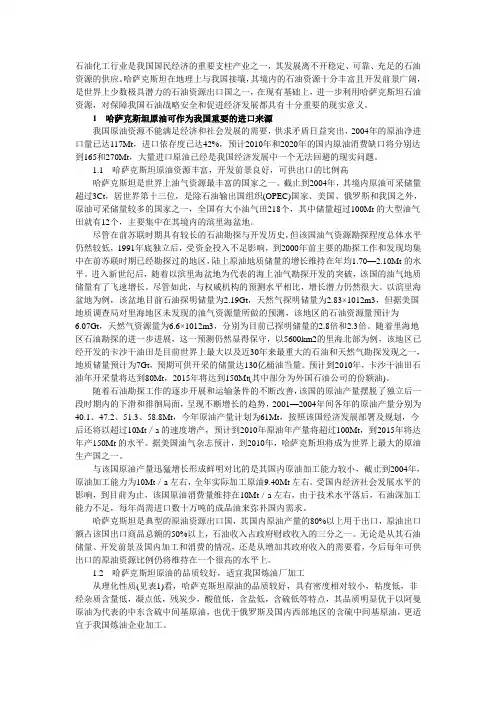
石油化工行业是我国国民经济的重要支柱产业之一,其发展离不开稳定、可靠、充足的石油资源的供应。
哈萨克斯坦在地理上与我国接壤,其境内的石油资源十分丰富且开发前景广阔,是世界上少数极具潜力的石油资源出口国之一,在现有基础上,进一步利用哈萨克斯坦石油资源,对保障我国石油战略安全和促进经济发展都具有十分重要的现实意义。
1哈萨克斯坦原油可作为我国重要的进口来源我国原油资源不能满足经济和社会发展的需要,供求矛盾日益突出,2004年的原油净进口量已达117Mt,进口依存度已达42%,预计2010年和2020年的国内原油消费缺口将分别达到165和270Mt,大量进口原油已经是我国经济发展中一个无法回避的现实问题。
1.1哈萨克斯坦原油资源丰富,开发前景良好,可供出口的比例高哈萨克斯坦是世界上油气资源最丰富的国家之一。
截止到2004年,其境内原油可采储量超过3Ct,居世界第十三位,是除石油输出国组织(OPEC)国家、美国、俄罗斯和我国之外,原油可采储量较多的国家之一,全国有大小油气田218个,其中储量超过100Mt的大型油气田就有12个,主要集中在其境内的滨里海盆地。
尽管在前苏联时期具有较长的石油勘探与开发历史,但该国油气资源勘探程度总体水平仍然较低,1991年底独立后,受资金投入不足影响,到2000年前主要的勘探工作和发现均集中在前苏联时期已经勘探过的地区,陆上原油地质储量的增长维持在年均1.70—2.10Mt的水平。
进入新世纪后,随着以滨里海盆地为代表的海上油气勘探开发的突破,该国的油气地质储量有了飞速增长。
尽管如此,与权威机构的预测水平相比,增长潜力仍然很大。
以滨里海盆地为例,该盆地目前石油探明储量为2.19Gt,天然气探明储量为2.83×1012m3,但据美国地质调查局对里海地区未发现的油气资源量所做的预测,该地区的石油资源量预计为6.07Gt,天然气资源量为6.6×1012m3,分别为目前已探明储量的2.8倍和2.3倍。

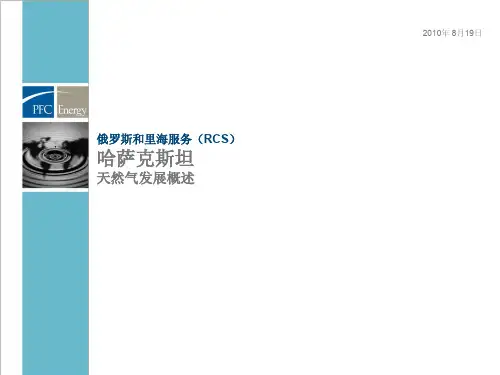


萨克斯坦共和国油气田开发统一规范2001年10月20日哈萨克斯坦共和国政府关于“批准哈萨克斯坦共和国油气田开发统一规范”的决议1996年6月28日第745号为了实施哈萨克斯坦共和国总统1995年6月28日签发的第2350令(《石油法》),哈萨克斯坦共和国政府决定:1、批准哈萨克斯坦共和国油气田开发统一规范(附件)2、资源使用者在油气田开发中必须遵守该统一规范3、哈萨克斯坦共和国油气工业部负责监督《哈萨克斯坦共和国油气田开发统一规犯》中各项条款的完成情况哈萨克斯坦共和国副总理什拖普克哈萨克斯坦共和国油气田开发统一规范序言首次制订哈萨克斯坦共和国油气田开发统一规范。
规范规定了哈萨克斯坦共和国境内的油气田的试采和工业性开发各阶段基本标准和要求,油气田地质研究,储量的计算与核算,设计和编制油气田合理开发方案,各类生产井和油田设施的建设和使用,开发过程的管理,资源和环境保护。
根据哈萨克斯坦共和国总统第2200令(1995年4月17日《许可证协议法》)、2350令(1995年6月28日《石油法》)、2828令(1996年1月27日《矿产资源使用法》)和其它法律条文制订本规范。
从油田普查开始到开发结束,根据长期不断获得的油藏信息及其更加详细的认识,在准则中规定了油气田开发设计和完成相应工作的程序。
根据早期已通过开发工艺技术方案及其相应协议,必须对油田开发进行监控和分析,并对油田开发方案的设计进行2-3次的修改。
1. 准备投入开发的油气田1.1 油气田1.11油气田------是指在一个区块分布一个或几个有利圈闭或者其它类型圈闭的油气藏。
1.1.2油藏------是指一个、两个、三个甚至更多储油层中有天然统一水动力系统的油气藏。
在油气田地质剖面上油气藏的数量可能和产层的数量相等或者比它少。
1.1.3 油气藏中地下原始烃类相态分为单相和双相:单相油气藏是指油藏中的原油只含有溶解气,气藏中只含有低分子量烃组成的天然气,凝析气藏中气里含有气态的凝析油。
KAZAKHSTAN - Part 2 - The OilProducing Ventures.鲁克从1997年进入哈萨克油气市场,至2005年底在哈萨克投资了45亿美元。
APS Review Oil Market Trends • July 28, 2008 •There are more than 170 fields in Kazakhstan, all onshore but with a major part of Tengiz having become offshore because of a rise in the Caspian Sea's level. Those in operation are producing a total of over 1.65m b/d of crude oil and condensate, up from 1.45m b/d in 2007 and 1.35m b/d in mid-2006. Crude oil and condensate output has risen from 828,000 b/d in 2001 and 609,000 b/d in mid-1998. The liquids output will exceed 3m b/d in 2015.Production of natural gas is set to rise from 29.6 BCM/year in 2007 to 114 BCM/year by 2020, according to the state-owned KazMunaiGaz (KMG). KMG President and CEO Uzakbai Karabalin was on Feb. 26, 2008, quoted as saying most of the increase in production will come from new gas fields in the west of the country as well as from "the resources of the Kazakh and Turkmen sectors in the Caspian" Sea. He said Kazakh consumption of natural gas was to grow from 13.3 BCM/year in 2007 to 18.7 BCM/year by 2020.Most fields are old and need rehabilitation, with only a few in good working condition. A number of old fields are out of operation and have many idle wells. For example Uzen, a large oilfield, has about 4,000 wells and only half of them are producing 100,000 b/d (from 55,000 b/d in mid-1998).There are 34 crude oil, condensate and producing firms in Kazakhstan. But of these only seven are producing 1.538m b/d of liquids. The other 27 firms are producing 112,500 b/d of liquids and varied volumes of natural gas. So the total for Kazakh liquids production in 2008 will average 1,650,500 b/d. Kazakhstan has the Caspian region's largest recoverable oil and condensate reserves, and its production of liquids accounts for over 55% of 3m b/d currently being produced in the region (including Azerbaijan, Turkmenistan and Uzbekistan).Below are brief profiles of the main Kazakh oil and condensate fields (for more details and the gas producing JVs see gmt5KazProdJuly28-08).Tengiz, an onshore/offshore oilfield operated by Chevron, is producing about 510,000 b/d of 47[degrees] API crude oil with 0.5% sulphur. Through an extensive EOR system based on natural gas, the field's output average later this year should reach 540,000 b/d - if Chevron's work proceeds according to plan. The field's output capacity is expected to increase to 700,000 b/d by end-2009 and 1m b/d by 2012/13.Tengiz is located in the swamp-lands along the north-eastern shores of the Caspian and is the largest source of crude oil production in the country. It has been developed since 1993 by the TengizChevrOil (TCO) joint venture (see profile of the JV in gmt5KazProdJuly28-08). Production averaged almost 280,000 b/d during 2007 and reached 510,000 b/d by mid-2008, with recoverable crude oil reserves having been estimated at 6-9 bn barrels by Chevron.According to Chevron, Tengiz could potentially produce 700,000 b/d by end-2009 and up to 1.4m b/d by 2012/13, with a sour gas injection programme fully implemented. Most of the crude oil is being sent through the Caspian Pipeline Consortium (CPC) artery to the Russian Black Sea port of Novorossiysk. Due to current government regulations against the flaring of associated sour natural gas, restrictions on flaring hurt oil production in 2005 and 2006. Repeated mechanical problems also hurt output in the first half of 2006.In 2007 the JV was fined around $609m by the authorities for environmental violations relating to the storage of over 9m tons of sulphur, a waste product of crude oil production at the field. A $1 bn plan to reinject the sour gas (SGI) is currently in operation having been tested in 2007, and is one factor in the field's increased production in late 2007 and in 2008. Full-scale implementation of SGI, along with newly-drilled wells (called the second generation project) should allow for an increase in crude oil production to more than 540,000 b/d during the second half of 2008.Karachaganak, an onshore oil and gas/condensate field is in northern Kazakhstan near the border with Russia's Orenburg field. In 2007, the field produced over 250,000 b/d of crude oil and condensate. Karachaganak is being operated by Karachaganak Integrated Organisation (KIO), a JV led by BG and Agip. Oil and condensate output should be raised to 500,000 b/d by 2010.According to KIO, the field holds around 8-9 bn barrels of oil and condensate and 47 TCF of natural gas. BG says most of these will be recoverable over the 40-year life of KIO's PSA. KIO members aim to triple output with up to $10 bn in investment within 6-8 years. In previous years, almost all of Karachaganak's crude oil production was processed at Russian facilities associated with the Orenburg field located just across the border. In April 2003, a pipeline spur southwards to Atyrau was completed which connects the Karachaganak field to Kazakhstan's primary export pipeline, the CPC venture. The link has enabled increased exports and has reduced the JV dependence on Russian buyers.KazMunaiGaz EP (KMG EP), the third largest oil producer with an output of 238,000 b/d in the first half of 2008, was created in March 2004 as a London-registered unit of the state-owned KMG Holding. The latter is a vertically integrated NOC producing oil and natural gas, as well as having a 50% stake in the 104,427 b/d Atyrau refining and petrochemical complex. KMG EP is to branch out of Kazakhstan to invest in both upstream and downstream ventures abroad (see omt6KazakhExprt-Aug4-08).On July 18, KMG EP said its crude oil output in the first half of 2008 was 5.899m tons (238,000 b/d), up 960,000 tons (19.4%) from the first half of 2007. The main reason for this was its acquisition of 50% in KazGerMunai (KGM) in April 2007 and KarazhanbasMunai (CCEL) in December. In the first half of 2008, KMG EP supplied 5.731m tons (231,000 b/d) of crude oil, including its share in KGM and CCEL. Exports in the first half of 2008 amounted to 4.389m tons (177,000 b/d).In the second half of 2008, KMG EP will overtake KIO as the second largest oil producer, with its output to reach 353,000 b/d. This is thanks to its acquisition of the 115,000 b/d MangistauMunaiGaz (MMG), under a deal initialled in late 2007 for buying the 70% holding of Central Asia Petroleum (CAP).CAP by then had become controlled by Rakhat Aliyev, the ex-husband of President Nursultan Nazarbayev's powerful daughter Dariga. Aliyev purchased most shares in CAP a few years earlier, and raised CAP's stake in MMG from 60% to 70%. CAP used to be a Guernsey-based unit of the Indonesian conglomerate Setdco (now Medco) of the Panigoro brothers of Indonesia; and in May 1997 it bought a 60% stake in MMG.Dariga Nazarbayev, a business tycoon and head of a media empire (see her profile and those of other Kazakh VIPs in down6KazWho-Aug4-08), played a role in the background of KMG EP's acquisition of MMG. But the acquisition has become a complicated issue in view of disputes over its valuation. MMG's assets, valued at $1.9 bn in 2006, are now being assessed with the help of local and foreign consultants because the price being demanded is way above what KMG EP has agreed to pay. Therefore the acquisition may not be completed in 2008 if no agreement on the assets' value has been reached.This is a highly-charged political issue, in view of a latent war going on between the Nazarbayevs and Aliyev. In recent years, MMG was the last big oil firm in Kazakhstan which overseas interests had hoped to acquire.PetroKazakhstan (PK), originally a Canadian company, is the fourth biggest oil producer in Kazakhstan. In 2005-06, PK was sold to China's biggest state-owned oil firm, China National Petroleum Corp (CNPC) and KMG EP. PK, which operates 12 oilfields fields and has several E&P blocks in Kazakhstan, has an average output of 170,000 b/d. A major part of its crude oil now is being exported to China through a pipeline completed in late 2005 and filled in 2006. Its biggest field is Kumkol, producing 70,000 b/d.A part of PK's crude oil production is being supplied to a local refinery owned by PK. Most of the refinery's output is marketed locally (see Downstream Trends of this week). PK includes a JV with KMG EP and German firms grouped in KazGerMunai (KGM) which operates three of PK's oilfields (see KMG EP expansions gmt5KazProdJuly28-08).UzenMunaiGaz (UMG) is the fifth largest oil producer, with an output in 2008 to average 135,000 b/d, down from over 140,000 b/d in 2006. UMG is seeking to increase its production of natural gas.After its creation in 2004, KMG E&P merged into its system two major oil and gas producing ventures: UMG, in which CNPC has a stake and now being expanded with a revival of many well kept idle for several years, and EnbaMunaiGaz (EMG) which produces about 55,000 b/d.CNPC-AktobeMunaiGaz, the sixth largest oil producer, CNPC-AMG's output in 2008 will average 120,000 b/d of crude oil and condensate. The largest oil firm in western Kazakhstan's Aktobe region, CNPC-AMG is developing the Zhanazhol, Kenkiyak over-salt and Kenkiyak sub-salt fields.In February 2008, CNPC-AMG completed construction of the first line of the third Zhanazhol gas processing plant in Aktobe. It has a 2.2 BCM/year capacity. The plant is designed to have three lines, with total capacity to process 6 BCM/year of gas. The second line is slated to come on stream in the fourth quarter of 2008 and the third in 2010.哈萨克斯坦西部油田公司情况介绍哈国油气工业基本情况介绍:哈萨克斯坦目前有60个钻修井承包商和160部钻修井机为170多个油田提供钻修井服务。